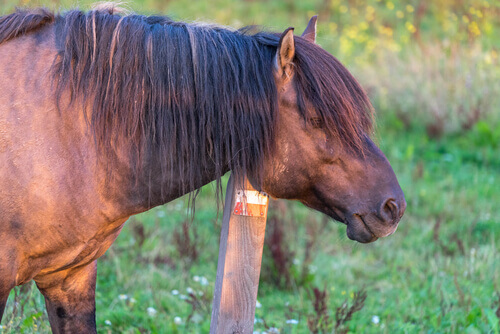The Care and Treatment of Horses with Scabies

Scabies is an infectious disease caused by mites, and it affects many different mammals, including humans. However, we’re not their preferred hosts. This pathology can become a problem in farm animals like horses because it’s contagious and passes easily from one animal to another. Therefore, it’s likely for scabies to spread throughout an entire stable if owners don’t isolate horses with scabies and treat them correctly. Here, we’ll show you how to identify scabies as well as how to treat it.
What is scabies?
Scabies, also known as mange, is an illness of the skin that’s caused by mites. There are several different species and genres of these bothersome scabies-causing invertebrates. However, one very common genre is Sarcoptes, which produces a great deal of itchiness in animals.
This mite digs tiny tunnels in the skin and produces an itchy sensation. In an attempt to calm their discomfort, horses will scratch themselves with their teeth. In the same way, they may rub up against other objects or roll around on the ground. This excessive scratching can produce skin lesions in affected areas.
Mites tend to live among animals that have long and abundant fur. Therefore, it’s common among workhorses, especially in the dense tufts of fur around the bottom of their legs, near their hooves.

- Sarcoptic mange. This is the most serious. These mites prefer areas with fine hair (head, neck, shoulders), where females can dig tunnels to deposit their eggs. This causes intense itching in horses.
- Psoriatic mange. This type of scabies affects any area of the body with long hear, like the forehead, the mane, and the base of the tail. The scabs are moist and the mites remain on the skin’s surface. Psoriatic mange is more contagious than sarcoptic mange, but less harmful.
- Corioptic mange. These mites prefer the area around the hind legs, especially the area of the hock joint and cannon where hair is abundant. The production of “fat” is a typical symptom.
- Demodectic mange. This isn’t very common in horses. In this case, the skin flakes but doesn’t itch.
How to identify horses with scabies
Horses with scabies may present an infection all over the body or just in concrete areas, depending on the type of mite that’s affecting the animal. The symptoms of scabies that we can identify are:
- Constant stomping
- Rubbing their back legs
- Scabs and papules on the head and ears – in the area of the neck, folds develop, which can spread all over the body in more serious cases
- Scabs on the back legs, mane, and the base of the tail
A veterinarian will evaluate the symptoms and perform a dermatological examination to identify the mite. They may conduct a series of tests, like scraping or placing adhesive tape on the horse’s skin. This allows them to take samples to analyze under a microscope to discover which mite is to blame.
Is scabies preventable?
When the environment is cold and moist, mites survive long periods of time far from their host. This makes it easier for them to spread by means of fomites. In other words, any object that comes in contact with a living creature that can potentially contain the pathogen.
In the case of horses, this can be bridles, blankets, saddles, or any other object, like brushes. However, the most common means of contagion is direct contact with an infected animal. In order to prevent the spread of mange, it’s important to maintain proper grooming and hygiene.
Mange is prevalent in horses that aren’t in good health.
How to treat horses with scabies
If you notice any of the symptoms of scabies, contact your veterinarian in order to receive the correct treatment. It’s important to treat all of the animals that live together in order to reduce or eliminate the likeliness of contagion.
Lindane baths are very effective when it comes to treating scabies in horses, but you must be thorough. Oral treatments with ivermectin, an antiparasitic used also in other animal species, can be a good solution.
Scabies is an infectious disease caused by mites, and it affects many different mammals, including humans. However, we’re not their preferred hosts. This pathology can become a problem in farm animals like horses because it’s contagious and passes easily from one animal to another. Therefore, it’s likely for scabies to spread throughout an entire stable if owners don’t isolate horses with scabies and treat them correctly. Here, we’ll show you how to identify scabies as well as how to treat it.
What is scabies?
Scabies, also known as mange, is an illness of the skin that’s caused by mites. There are several different species and genres of these bothersome scabies-causing invertebrates. However, one very common genre is Sarcoptes, which produces a great deal of itchiness in animals.
This mite digs tiny tunnels in the skin and produces an itchy sensation. In an attempt to calm their discomfort, horses will scratch themselves with their teeth. In the same way, they may rub up against other objects or roll around on the ground. This excessive scratching can produce skin lesions in affected areas.
Mites tend to live among animals that have long and abundant fur. Therefore, it’s common among workhorses, especially in the dense tufts of fur around the bottom of their legs, near their hooves.

- Sarcoptic mange. This is the most serious. These mites prefer areas with fine hair (head, neck, shoulders), where females can dig tunnels to deposit their eggs. This causes intense itching in horses.
- Psoriatic mange. This type of scabies affects any area of the body with long hear, like the forehead, the mane, and the base of the tail. The scabs are moist and the mites remain on the skin’s surface. Psoriatic mange is more contagious than sarcoptic mange, but less harmful.
- Corioptic mange. These mites prefer the area around the hind legs, especially the area of the hock joint and cannon where hair is abundant. The production of “fat” is a typical symptom.
- Demodectic mange. This isn’t very common in horses. In this case, the skin flakes but doesn’t itch.
How to identify horses with scabies
Horses with scabies may present an infection all over the body or just in concrete areas, depending on the type of mite that’s affecting the animal. The symptoms of scabies that we can identify are:
- Constant stomping
- Rubbing their back legs
- Scabs and papules on the head and ears – in the area of the neck, folds develop, which can spread all over the body in more serious cases
- Scabs on the back legs, mane, and the base of the tail
A veterinarian will evaluate the symptoms and perform a dermatological examination to identify the mite. They may conduct a series of tests, like scraping or placing adhesive tape on the horse’s skin. This allows them to take samples to analyze under a microscope to discover which mite is to blame.
Is scabies preventable?
When the environment is cold and moist, mites survive long periods of time far from their host. This makes it easier for them to spread by means of fomites. In other words, any object that comes in contact with a living creature that can potentially contain the pathogen.
In the case of horses, this can be bridles, blankets, saddles, or any other object, like brushes. However, the most common means of contagion is direct contact with an infected animal. In order to prevent the spread of mange, it’s important to maintain proper grooming and hygiene.
Mange is prevalent in horses that aren’t in good health.
How to treat horses with scabies
If you notice any of the symptoms of scabies, contact your veterinarian in order to receive the correct treatment. It’s important to treat all of the animals that live together in order to reduce or eliminate the likeliness of contagion.
Lindane baths are very effective when it comes to treating scabies in horses, but you must be thorough. Oral treatments with ivermectin, an antiparasitic used also in other animal species, can be a good solution.
All cited sources were thoroughly reviewed by our team to ensure their quality, reliability, currency, and validity. The bibliography of this article was considered reliable and of academic or scientific accuracy.
- Zoetis. Infecciones por ectoparásitos en los caballos.
- Will A. Haddenn. Enciclopedia Veterinaria Del Caballo, 2009.
- Vogel Colin, Ana Lima. La salud del caballo: una guía rápida para diagnosticar problemas.
This text is provided for informational purposes only and does not replace consultation with a professional. If in doubt, consult your specialist.








